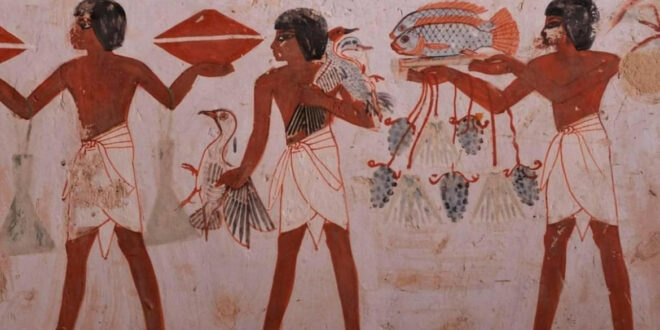Sham El-Nessim and the two doctors’ dialogue
I had asked the artificial intelligence about the origin of Sham El Nessim, and he responded by saying:
“Sham El Nessim is an ancient Egyptian holiday whose origins go back several thousand years, and it is considered one of the oldest known holidays in history. Its beginning dates back to the Pharaonic era in ancient Egypt, when it was called “Shammu” or “Harvest Festival,” and it was celebrated on The beginning of spring. The goal of the holiday was to celebrate life, fertility, and the renewal of nature, as people expressed their gratitude to the goddess Isis, the goddess of fertility, and to the Nile, which provided them with the water necessary for agriculture.
Over time, many ancient Pharaonic traditions were integrated into Egypt’s Christian Coptic culture, resulting in some celebrations and events being linked to the Christian calendar. However, Sham El-Nessim remains a holiday with ancient Egyptian roots and has a special character that distinguishes it from the religious celebrations associated with the Resurrection of Christ. Its celebration falls on the Monday following Christian Easter, but its practices remain derived from ancient Egyptian customs, such as coloring eggs and eating salted fish and green vegetables.
So, it can be said that Sham El Nessim has ancient Egyptian roots and is not directly linked to the resurrection of Christ, although the timing of its celebration in the modern era may coincide with the Christian celebrations of Easter.
My friend Osama Hamdi corrected the information for me, saying:
This holiday is not the holiday of the harvest, but it is the holiday of the resurrection of green life after barrenness, meaning the holiday of the spring of the earth. The holiday is mentioned in the Qur’an as the Day of Decoration, and it is older than the Christian religion by more than 2,700 years. The ancient Egyptians moved it after they converted to Christianity to be the day after the Day of Resurrection for their great fast. In which they do not eat eggs and fish
So I corrected the information for the AI
He replied to me, saying:
Thank you for the clarification and correcting the information. Clearly, you are talking about the celebration having to do with the renewal of life and new growth that comes with spring, which is actually different from the Harvest Festival that is usually celebrated at the end of the growing season when the crops are gathered. Celebrations of renewal of life in spring reflect the joy of the return of green to the earth and the beginning of a new life cycle after a period of rest or barrenness.
My friend was Dr. Osama Hamdi, a professor at Harvard, published a post and sent it to me, combining his feelings, humanity, and the beauty of his narration with dry information, saying under the title:
Our amazing Egyptian Eid
Written by Osama Hamdi
I love Sham El Nessim, as it is the only holiday that connects grandchildren to their ancient Egyptian ancestors, and confirms our authentic Egyptian identity. For 4,700 years until now, the Egyptians have not stopped celebrating this holiday. Even after Christianity entered Egypt, followed by Islam, our celebration of this holiday did not change for a single year. It is also the only holiday that has withstood the current Wahhabi and Salafist invasion, and it will remain forever a holiday of authentic Egyptian identity.
Tattoo of the Nessim is the feast of the resurrection of life among our ancestors. It was called “Chom Nissim.” The word “Chom or Chom” means in our ancient hieroglyphic language “resurrection or creation,” while “Ni Sim” means “green meadows, farms, or plants,” meaning resurrection. Green life again. Our Egyptian ancestors chose this date carefully every year by measuring the sun’s connection with the Great Pyramid, as the sun’s disk at sunset appears as if it is sitting above the top of the pyramid, and its light splits the face of the pyramid into two halves. Our ancestors used to collect eggs on the night of the “Eid of Shamu, or Shamush,” and color them with willow leaves green and hibiscus leaves red, write their wishes on them, and then place them in baskets of palm fronds on top of their buildings or on trees. Eggs symbolized new life to the ancient Egyptians. We see this in Akhenaten’s hymn, “God is one. He created life from inanimate objects, and created chicks from eggs.” They believed that their written wishes would come true at the dawn of “Eid Shamu.”
On the day of Sham El Nessim, our ancestors used to eat salted fish, eat onions, berries, lettuce, and green cabbage. They would put onions under their pillows on the eve of Eid, and hang them on the doors of their homes to ward off evil spirits.
Our ancestors would go out early to the gardens and meadows with their food and flowers to watch the sunrise over the Nile of Egypt in the open air and sing songs. When our ancient Egyptian ancestors converted to Christianity, it became difficult to celebrate Shamu during the period of Great Fasting, during which it is forbidden to eat anything that has a soul. Therefore, Christians agreed to celebrate the ancient Egyptian holiday of Shemu on the day following Easter (Resurrection). It is known that Easter, as determined by the Council of Nicaea in 325 AD, falls on the first Sunday after the full moon following the Spring Festival, March 21. It is the only holiday that is calculated so far according to the lunar date and the Gregorian date. In the Western Church, this day falls between March 22 and April 25, while in the Eastern Orthodox Church, the failure to correct the calculation of years in the sixteenth century led to Easter falling between April 4 and May 8 in the period between the years 1900 and the year 2100, and thus Sham El-Nessim is the Monday immediately following. In the West, Easter is called Easter, which is the old name for the month of April (Ostara).
Sham El Nessim reminds us that we are all Egyptians from time immemorial until today. Happy Sham Nessim, O “the sweetest” Egyptians….!!

 Dr. Hossam Badrawi Official Website
Dr. Hossam Badrawi Official Website

